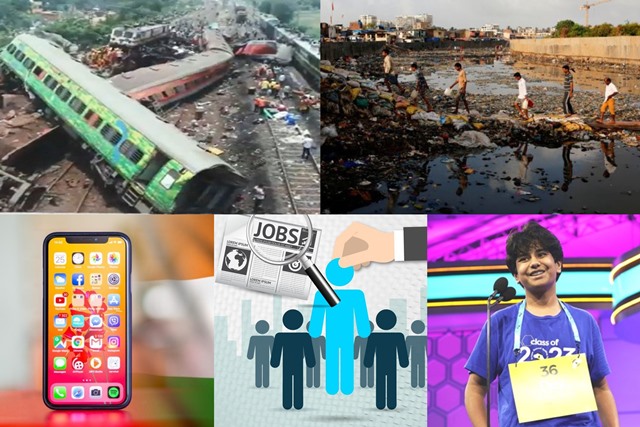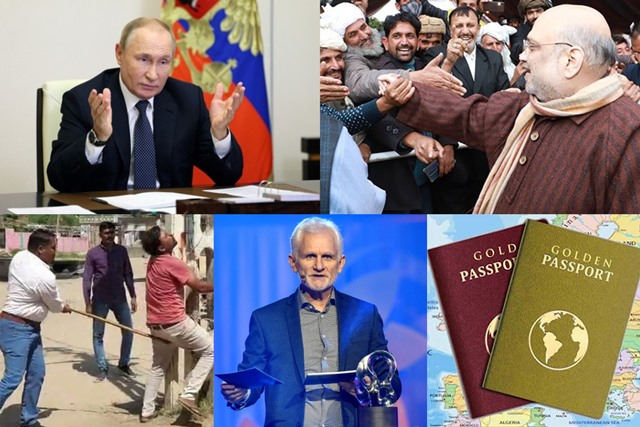The worst recorded railway accident in India occurred in 1981 when an overcrowded passenger train was blown off the tracks and into a river during a cyclone in Bihar state, killing at least 800 people. This weekend another horrific accident involving three trains in the state of Odisha left nearly 300 people dead and 900 injured.
In the worst-ever railway accident in 1981, it was a terrible cyclone that had blown off the train, which plunged into a river. But last weekend’s accident was caused by a derailment. One long-distance passenger train overshot the tracks and smashed into another, and, going by initial reports, eventually, the collision carried on into a standing freight train.
The number of major railway accidents, to be fair, has reduced in the past 50 years. The railways have taken many measures to increase safety of operation, track upgrades, and technology to manage train movement. Yet, of the 10 train accidents that took place between 2018 and 2021, seven were because of derailments.
Train derailments mostly happen because rail tracks fracture or crack because of expansion and contraction on account of ambient temperature changes—extreme heat in summer followed by cold winters. The phenomenon of fractured tracks is the biggest challenge for the Indian Railways, which oversees a network that spans 128,305 km of track length, 102,831 km of running track length and 68,043 km of route length.
Derailments usually take place as a result of a combination of factors: mechanical glitches, signaling failures, and track construction faults. Railways often complain about lack of funds for maintenance and modernization of the track network. A Comptroller and Auditor General report showed that shortage of funds and underutilization of resources were to blame for at least a quarter of railway derailments. Many believe the pace of introducing new and faster trains is faster than the pace of implementing safety and infrastructure measures. Coach overloading and stress on tracks are also factors that can contribute to derailments.
Spending more on railway infrastructure and track safety could be one of the steps in the way ahead. In February this year, India allocated a capital outlay of Rs 2.4 lakh crore for the railways. This is the highest ever allocation to the Indian railways. Even this could be inadequate for the required infrastructure needs of the network.
The other problem is overloading and overcapacity in the system. Some experts believe that utilization capacity should be reduced to 60-70% in order to have the system work at the best levels.
14 of the 20 most polluted cities in the world are in India
Indian cities continue to dominate the list of most polluted places in the world. Fourteen of the top 20 most polluted cities in the world are in India. New Delhi, Greater Noida, Faridabad, and Ghaziabad, together comprising most of India’s National Capital Region, all feature on the list compiled by the World Health Organization (WHO).
The WHO uses the concentration of PM2.5 (suspended particulate matter of 2.5 micrometers or less in a given volume of air) as an indicator of air pollution. For purposes of ranking, WHO has considered the average value of the indicator during 2022. Delhi with an average of 92.6 is the fourth most polluted city in the world. Ahead of Delhi are Lahore in Pakistan 97.4, Hotan in China 94.3, and Bhiwadi in India 92.7.
As India’s population has outpaced China, its number of most-polluted cities has also overtaken China’s. The hazards of living in an environment of poor air quality cannot be overemphasized. It is the biggest cause of premature death globally after high blood pressure, inadequate diet and smoking. According to the Health Effects Institute, an independent, US-based non-profit corporation specializing in research on the health effects of air pollution, 6.7 million people died as a result of air pollution in 2019. In addition, the global health-related cost of air pollution related diseases is estimated to be around US$8.1 trillion.
In Indian cities such as Delhi and its satellite urban centres, the focus on reducing pollution spikes when the air quality levels reach catastrophic (and not just hazardous) levels. Usually this is in winters when smog and concentrated particulate matter increases and the effects are most palpable. Once it gets warmer and things improve (read: get back to normally hazardous levels) the furore dies down. What India needs is continuous efforts to reduce air pollution, including emissions from industries, crop stubble burning, vehicular emissions, and so on. Meanwhile, the country continues to remain high on the ignoble list of the world’s most polluted cities.
Is India just an assembler of iPhones, not a manufacturer?
In 2022-23, official estimates suggest that India achieved a record $10 billion (Rs 82,000 crore) worth of smartphone exports. This was touted to be the outcome of the Production Linked Incentive, or PLI, scheme of the government. PLI is a form of performance-linked incentive to give companies incentives on incremental sales from products manufactured in domestic units and is aimed at boosting the manufacturing sector and to reduce imports.
But shortly after those figures were released there was a dampener. Early last week, in a social media post, the former Reserve Bank of India governor, Raghuram Rajan, a noted critic of India’s economic policies in recent years, stated that the sharp rise in mobile phone exports out of India was fuelled largely assembly of devices in India using imported components rather than full-scale manufacturing of the phones.
In a column published on LinkedIn, Rajan, who is now a professor at the Chicago University, has explained that the growth in cellphone exports may be more on account of assembly of phones in India rather than genuine manufacturing. This, Rajan explains, is because the PLI scheme accords incentives based on the finished phone rather than on the value added by manufacturing in India. Much of the cellphone exports are that of cellphones assembled from imported components. Once the imports are offset against the value of the exports of the assembled phones, the value of manufacturing them in India is not nearly as what may be reflected by the total or gross export values.
According to Rajan, “We certainly cannot claim the rise in exports of finished cell phones is evidence of India’s prowess in manufacturing. Manufacturers are likely engaging in only assembly…”
The PLI scheme was introduced in 2020 to spur local production of mobile phones and offers companies an incentive of 4-6% on incremental sales of goods that are manufactured in India. The incentive is available for five years. If Indian companies are importing much of the cellphone components, including the processors or chips (which are the most high technology components of cellphones), the real value addition by manufacture in India is not the same as the total export value. Rajan has called for a review of the PLI scheme to make it really work as a booster for manufacture in India.
The spectre of jobless growth
India’s economy has been growing at a fast pace in recent years. It is estimated that the Indian economy will grow at a world leading rate of 6.5% for the fiscal year ending in 2024. Yet, jobs are not being created. India is still grappling with high unemployment rate. Overall, in the economy, according to the Centre for Monitoring Indian Economy (CMIE), India’s unemployment rate has been hovering around 7% or 8%, up from about 5% five years ago.
In urban India, the situation could be worse. During the COVID pandemic, urban unemployment was estimated to have touched nearly 21% and wages declined. While the rate of unemployment has declined since, there is a lack of fulltime jobs. Many young job seekers are either opting for lower paid jobs or on self-employment options, which are not adequately remunerative.
The reasons for the paradox—relatively high growth rates but low job generation– are complex and multifaceted. One reason is that India’s economy is still heavily dependent on agriculture, which employs a large percentage of the population but is not very productive. Another reason is that many of the jobs being created are in low-paying sectors such as retail and hospitality. Additionally, there is a mismatch between the skills that workers have and the skills that employers are looking for.
There are also structural issues with India’s labour market. For example, many workers are employed in the informal sector, which means they do not have access to benefits such as health insurance or retirement plans. Furthermore, labour laws in India can be complex and restrictive, which can discourage employers from hiring more workers.
Tackling the challenge of breaking out of the jobless growth syndrome is all the more crucial in a country that has already become the world’s most populous and where the number of people between the age of 15 and 64 is nearly 945 million.
Indians dominate American spelling contest
Last weekend, a 14-year-old boy won an annual spelling competition after successfully spelling the word “psammophile”. The word, psammophile, if you’re curious, describes an organism that lives or thrives in sandy areas. Dev Shah, an Indian origin boy from Largo, Florida, won the Scripps national Spelling Bee competition for 2023 and received $50,000 in cash for his achievement.
The spelling bee competition has become almost a domain of young people from the Indian community in the US. The bee began in 1925 and is open to students through the eighth grade. What is significant is that since 1985 when Balu Natarajn won the Scripps bee, Indian-origin students have been dominating the contest as winners through the years.

